|
Making Syrup (2009)
The season of the syrup campaign caught me short on time. It would be nice to imagine that that is atypical, but, alas, not. (I do have some serious hopes for the future, though, as I retire in May, 2010.) With the winter closing in, priorities were set by thoughts of freeze damage. Three tasks presented themselves in order, viz., save some of my citrus, insulate new pipes at the farm, and make syrup. Fortunately, because of the late season, I was able to do all three.
I am not sure that I agree with the reputation that satsumas have for not storing well on the tree. I certainly do agree, however, with their reputation for holding up well in storage. Thus, each year, I box up about 80 pounds in late November, ideally, and enjoy them until about April, when they begin to show their age. On an "on year," this amount doesn't begin to make a dent in my crop, so I give boxes and boxes away, and I shared this year, too.Until her death, I always juiced many and stored the juice for my sister, who, like I, was sensitive to the oils in citrus peel. But, still, too many satsumas! I decided, thus, to pick some and take them to a Tallahassee food 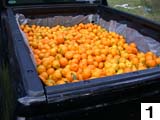 distribution center that advertises distribution of fresh produce to food pantries. Nedra and I picked conservatively 350 pounds (Slide 1), an estimate made on the basis of box weight. Four hundred pounds would likely be a more accurate estimate. Because satsumas are very delicate, I only stacked them about 6 deep, and my plan was to pick that many more for the same purpose later. I was disappointed, disillusioned, and surprised at the reception that this fruit received. I had expected that the fruit would have been packed in plastic lettuce trays (of which they had an abundance empty) for redistribution. To cut to the chase, the person in charge seemed not to care and the "helpers" were playing with the fruit (juggling) and throwing it into a large bin, in which it would have been damaged by its own weight regardless. Obviously, I had no enthusiasm for that, so I stopped this tomfoolery. Nedra and I went to a church-sponsored rehab center, which has a number of permanent residents and which serves dinner to a homeless population. I had donated from my chicken house and garden weekly to this location until the elders fired the resident manager (as I understand, for using too many trash bags). I really thought he and his wife were saints, and I stopped going there. At any rate, the administration of the center had changed tremendously, not for the better, but we were able to give away about half the satsumas there. We attempted to give the remainder to another shelter, but neither the office staff nor that of the kitchen feigned enough interest to go out to look at them. Elsewhere, I gave away some more, and the remainder were dumped on the ground. At the time that I was attempting to give these very high quality satsumas away, lesser ones were going for $1.69/lb at the local coop. By next year, however, I hope to have a better solution, but same goal.. distribution center that advertises distribution of fresh produce to food pantries. Nedra and I picked conservatively 350 pounds (Slide 1), an estimate made on the basis of box weight. Four hundred pounds would likely be a more accurate estimate. Because satsumas are very delicate, I only stacked them about 6 deep, and my plan was to pick that many more for the same purpose later. I was disappointed, disillusioned, and surprised at the reception that this fruit received. I had expected that the fruit would have been packed in plastic lettuce trays (of which they had an abundance empty) for redistribution. To cut to the chase, the person in charge seemed not to care and the "helpers" were playing with the fruit (juggling) and throwing it into a large bin, in which it would have been damaged by its own weight regardless. Obviously, I had no enthusiasm for that, so I stopped this tomfoolery. Nedra and I went to a church-sponsored rehab center, which has a number of permanent residents and which serves dinner to a homeless population. I had donated from my chicken house and garden weekly to this location until the elders fired the resident manager (as I understand, for using too many trash bags). I really thought he and his wife were saints, and I stopped going there. At any rate, the administration of the center had changed tremendously, not for the better, but we were able to give away about half the satsumas there. We attempted to give the remainder to another shelter, but neither the office staff nor that of the kitchen feigned enough interest to go out to look at them. Elsewhere, I gave away some more, and the remainder were dumped on the ground. At the time that I was attempting to give these very high quality satsumas away, lesser ones were going for $1.69/lb at the local coop. By next year, however, I hope to have a better solution, but same goal..
As it was all under my control, I had better success at protecting the pipes at the farm. I wrapped the inside and outside pipes with foam (R2), which was held in place  by 10-mil PVC tape (Slide 2), except for a small hole at the top to allow air into the top section of pipe after each cycle of the pump. This was the starting point for building a well house on the slab, but this year, two additional layers of plastic-backed fiberglass (~R8, each), further protected by two layers of Visqueen heeled in around the slab and covered by a plastic tarp (to prevent too much solar gain) had to suffice. On the inside of my ag building, I put foam in place and more-or-less sealed the north doors with Visqueen. The north/northwest is the direction from which winds come and that seal, using greenhouse channel "locks," worked better than I had hoped. by 10-mil PVC tape (Slide 2), except for a small hole at the top to allow air into the top section of pipe after each cycle of the pump. This was the starting point for building a well house on the slab, but this year, two additional layers of plastic-backed fiberglass (~R8, each), further protected by two layers of Visqueen heeled in around the slab and covered by a plastic tarp (to prevent too much solar gain) had to suffice. On the inside of my ag building, I put foam in place and more-or-less sealed the north doors with Visqueen. The north/northwest is the direction from which winds come and that seal, using greenhouse channel "locks," worked better than I had hoped.
Syrupmaking was the third priority and, as mentioned, the weather held out. Although there had been a little nip in the air (just enough to burn the tips of my bananas), the cane and even most of the eyes were still good until I made one round on December 16th.
I have three small patches of cane and this year I only cut from the "apiary patch" down front. (The remainder 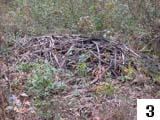 of my cane was done in by the bitterly cold and long blasts of Artic air--probably a record of low averages--that we suffered through in mid January. Is this really Florida?). Except for a bit of Green German and CP 89-2143, all of this patch came from stubble cane. Last year, I discarded much cane from this patch (Slide 3) when the interiors of the stalks were infected by something I called Red Rot.(I don't grind any cane with apparent disease.) I expected the disease to be worse this year, but actually only one stalk showed the faintest infection. We had a sufficiently wet year and I harvested late. I don't have an explanation, but do appreciate whatever factors were responsible. of my cane was done in by the bitterly cold and long blasts of Artic air--probably a record of low averages--that we suffered through in mid January. Is this really Florida?). Except for a bit of Green German and CP 89-2143, all of this patch came from stubble cane. Last year, I discarded much cane from this patch (Slide 3) when the interiors of the stalks were infected by something I called Red Rot.(I don't grind any cane with apparent disease.) I expected the disease to be worse this year, but actually only one stalk showed the faintest infection. We had a sufficiently wet year and I harvested late. I don't have an explanation, but do appreciate whatever factors were responsible.
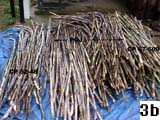
Slide 3b shows most of the the washed cane, ready to grind. However, first, I ground a small amount of Green German (less than 2 % of total juice) to test the brix (= 20.1), and likewise CP 89-2143 (3% of total juice, brix = 21.0). I am interested in high-brix canes because, of course, the energy required per gallon of syrup would be less. On the other hand, I have tried several varieties of canes over the years; I have found some that I was fond of for one reason, but rejected for other reasons. Now, I have reached the stage of my life where cultivar testing is less appealing. About 10% of the juice came from CP 52-48 (brix =16.0); I obtained this cane unidentified from Charles Deese. I would not propagate CP 52-48 from this cane, but I am almost certain that it is that cultivar. The remaining 85% of the juice came equally from CP 67-500 (brix=16.8%) and POJ (brix=16.9%). There was no difference in brix in the POJ (=Proefstation Oost-Java) that had lodged and that which had remained erect. I had originally obtained this cane from the late Don Dean, but lost it. I got another start of it from Leon Robinson and the late Zack Hicks, who, in turn had obtained it from Don. I believe that it is POJ 213. A table of other brix values is available.
 I cut barely enough cane (Slide 4); judgment is problematic with crooked and thin cane, and the small-bore POJ yielded less juice on a mass basis. I cut barely enough cane (Slide 4); judgment is problematic with crooked and thin cane, and the small-bore POJ yielded less juice on a mass basis.
As it came out of the mill, the juice was strained by two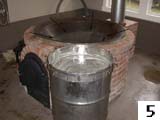 layers of stainless-steel mesh and then was passed through three layers of diaper. The juice (Slide 5, composite brix=17.0%; temperature=58 F) ) was ready to process at 1028. The arrows layers of stainless-steel mesh and then was passed through three layers of diaper. The juice (Slide 5, composite brix=17.0%; temperature=58 F) ) was ready to process at 1028. The arrows 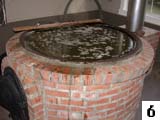 in the kettle show the limit of the firebox underneath the kettle (The firebox is made of fire brick and sealed to the kettle with fire clay. I hope to be able to post more on this topic later.) My kettle is nominally 60 gallons, which is perhaps misleading--a 60-gallon kettle only holds 50 gallons up to the rim (Slide 6). in the kettle show the limit of the firebox underneath the kettle (The firebox is made of fire brick and sealed to the kettle with fire clay. I hope to be able to post more on this topic later.) My kettle is nominally 60 gallons, which is perhaps misleading--a 60-gallon kettle only holds 50 gallons up to the rim (Slide 6).
As described elsewhere, the juice was heated to 135 F (1058) 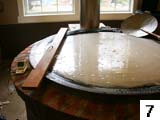 and held for incubation with invertase. The flame was reignited at 1128 and 10 min later, the juice had reached 180 F where skimmings began to accumulate (Slide 7). The juice had heated to 200 F by 1143, and I started skimming at 210 F. During the intense period of heating, the flue temperature reached 910 F and the propane pressure dropped to 4.2 psi, from a static pressure of 5 psi. (My propane tank is nominally 120 gallons, but it is filled to only 80% capacity. Whether the pressure drop is due to vaporzation limitation or pressure drop in the line, I don't know. I had planned to run 5/8" soft copper, but it wound up being 1/2", and with tubing, that nominal dimension is from the outside. Anyhow, under these conditions, the heat output approaches 700,000 BTU/h, which is more than sufficient.) and held for incubation with invertase. The flame was reignited at 1128 and 10 min later, the juice had reached 180 F where skimmings began to accumulate (Slide 7). The juice had heated to 200 F by 1143, and I started skimming at 210 F. During the intense period of heating, the flue temperature reached 910 F and the propane pressure dropped to 4.2 psi, from a static pressure of 5 psi. (My propane tank is nominally 120 gallons, but it is filled to only 80% capacity. Whether the pressure drop is due to vaporzation limitation or pressure drop in the line, I don't know. I had planned to run 5/8" soft copper, but it wound up being 1/2", and with tubing, that nominal dimension is from the outside. Anyhow, under these conditions, the heat output approaches 700,000 BTU/h, which is more than sufficient.)
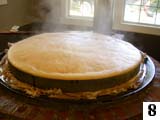 The temperature of the juice was held just below boiling until about 1215. By 1310, the operation was self skimming (Slide 8). I am OCD and always afraid that I won't get it up "over the rim." . . . but, of course, I've seen good syrup made without a rim. By this time, the boiling point of the juice had reached 215 F. At 1400, I changed the diapers that are packed around the rim. (The skimmings float on the top of the boiling liquid and ride over the rim. They are caught on the filter and the liquid returns to the kettle.) I usually change the diapers three times, the last about 20-30 minutes before I expect the syrup to be finished. The temperature of the juice was held just below boiling until about 1215. By 1310, the operation was self skimming (Slide 8). I am OCD and always afraid that I won't get it up "over the rim." . . . but, of course, I've seen good syrup made without a rim. By this time, the boiling point of the juice had reached 215 F. At 1400, I changed the diapers that are packed around the rim. (The skimmings float on the top of the boiling liquid and ride over the rim. They are caught on the filter and the liquid returns to the kettle.) I usually change the diapers three times, the last about 20-30 minutes before I expect the syrup to be finished.
Syrupmakers use a number of means of judging when the syrup is ready to take up. The b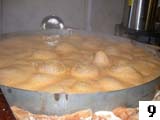 oiling temperature increases (of course), as does the density (of course). Visual means of monitoring progress include viscosity (forming a sheet when it poured off the edge of a skimmer or dipper), color, surface characteristics, and sometimes the syrup "falls," meaning that the boiling surface drops to a lower position. Slide 9 shows the characteristically large bubbles ("hog eyes," "frog eyes") that indicate the syrup is near ready. This photograph was taken at 1449, when the boiling point was 224 F and the density was 31 degrees Baume. The first hog eyes were observed at 1435 and the syrup was taken up about 1500, when the density was 34.5 degrees. Thus, seeing the first large bubble is an indication that I need to change the diapers for the last time. oiling temperature increases (of course), as does the density (of course). Visual means of monitoring progress include viscosity (forming a sheet when it poured off the edge of a skimmer or dipper), color, surface characteristics, and sometimes the syrup "falls," meaning that the boiling surface drops to a lower position. Slide 9 shows the characteristically large bubbles ("hog eyes," "frog eyes") that indicate the syrup is near ready. This photograph was taken at 1449, when the boiling point was 224 F and the density was 31 degrees Baume. The first hog eyes were observed at 1435 and the syrup was taken up about 1500, when the density was 34.5 degrees. Thus, seeing the first large bubble is an indication that I need to change the diapers for the last time.
The syrup was cooked to a higher density than I expected (maybe I was slower taking it up?) and I started off with slightly less juice. Thus, the yield was 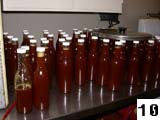 somewhat less than usual. Interestingly, the syrup was lighter in color than I have made before (Slide 10), perhaps compliments of the POJ. (Incidentally, Carol Dean has indicated that POJ was Don's favorite, and it receives high praise for syrup quality in the old literature.) For the first time, my syrup was hazy and foam was present. I can't explain why it was hazy, but expect that the flocculate that usually settles remained suspended because of the higher density this go-around. But, there were other variables, such as season, lateness in making syrup, a new blend of cultivars. There's always a lot to be learned in the art of making syrup. somewhat less than usual. Interestingly, the syrup was lighter in color than I have made before (Slide 10), perhaps compliments of the POJ. (Incidentally, Carol Dean has indicated that POJ was Don's favorite, and it receives high praise for syrup quality in the old literature.) For the first time, my syrup was hazy and foam was present. I can't explain why it was hazy, but expect that the flocculate that usually settles remained suspended because of the higher density this go-around. But, there were other variables, such as season, lateness in making syrup, a new blend of cultivars. There's always a lot to be learned in the art of making syrup.
This essay now turns to the aftermath of syrup making. Just as with making the syrup, syrupmakers have devised different means of cool-down and clean up. It all works out somehow.
I have a unfounded fear of cracking my kettle. Indeed, as my syrup shed was erected, I installed 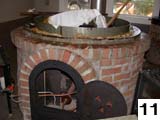 a support so that one person can change a kettle out. (I usually work and play alone.) I also procured additional identical kettles "just in case." On the one hand, I have seen a lot of broken kettles. On the other hand, I have seen pretty serious abuse of kettles with no deleterious result. Maybe all the kettles that are prone to crack have cracked sometime in the past century or so? Regardless, I try to be as gentle as possible. As soon as the syrup is taken up (Slide 11), I open the furnace door, close the shed windows and turn the exhaust fan on maximally. Thus, air is pulled down the flue through the fire box. Then, I spray water judiciously on the inside of the kettle, trying to spray all areas of the kettle equally. One can argue from several different angles, and I can't say that I know what is best. a support so that one person can change a kettle out. (I usually work and play alone.) I also procured additional identical kettles "just in case." On the one hand, I have seen a lot of broken kettles. On the other hand, I have seen pretty serious abuse of kettles with no deleterious result. Maybe all the kettles that are prone to crack have cracked sometime in the past century or so? Regardless, I try to be as gentle as possible. As soon as the syrup is taken up (Slide 11), I open the furnace door, close the shed windows and turn the exhaust fan on maximally. Thus, air is pulled down the flue through the fire box. Then, I spray water judiciously on the inside of the kettle, trying to spray all areas of the kettle equally. One can argue from several different angles, and I can't say that I know what is best.
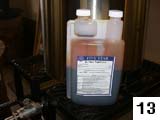
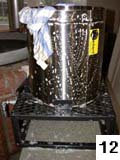 I wash my bottler with dish detergent (Slide 12), rinse it well, then run a sanitizer through it (Slide 13) while moving the valve handle through the limits of its excursion. Finally, I run boiling water through it (Slide 14), again, while working the valve handle. I wash my bottler with dish detergent (Slide 12), rinse it well, then run a sanitizer through it (Slide 13) while moving the valve handle through the limits of its excursion. Finally, I run boiling water through it (Slide 14), again, while working the valve handle.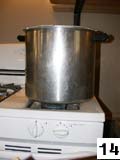
Many syrupmakers prefer to leave a layer of syrup on the kettle until the following season (when it is cleaned before use). It is a matter of personal preference, but I have always cleaned my kettle 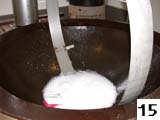 well with soap and water (Slide 15) and dried it. I've had no trouble, e.g., with rust formation. well with soap and water (Slide 15) and dried it. I've had no trouble, e.g., with rust formation.
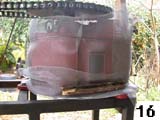 The final cleanup at my shed involves my working mill (Slide 16). I wash the mill with water, blow it out, spray oil on the rollers and bottom surfaces, and fill the wells with oil. Then, I screen it to prevent insects or rodents from going in it. (I have never had trouble with rodents going into this mill--perhaps they can't climb into it--but they do make their homes in mills. I don't think I could ever use the mill after seeing a rodent in it unless I completely disassembled it . . . .) The final cleanup at my shed involves my working mill (Slide 16). I wash the mill with water, blow it out, spray oil on the rollers and bottom surfaces, and fill the wells with oil. Then, I screen it to prevent insects or rodents from going in it. (I have never had trouble with rodents going into this mill--perhaps they can't climb into it--but they do make their homes in mills. I don't think I could ever use the mill after seeing a rodent in it unless I completely disassembled it . . . .)


|